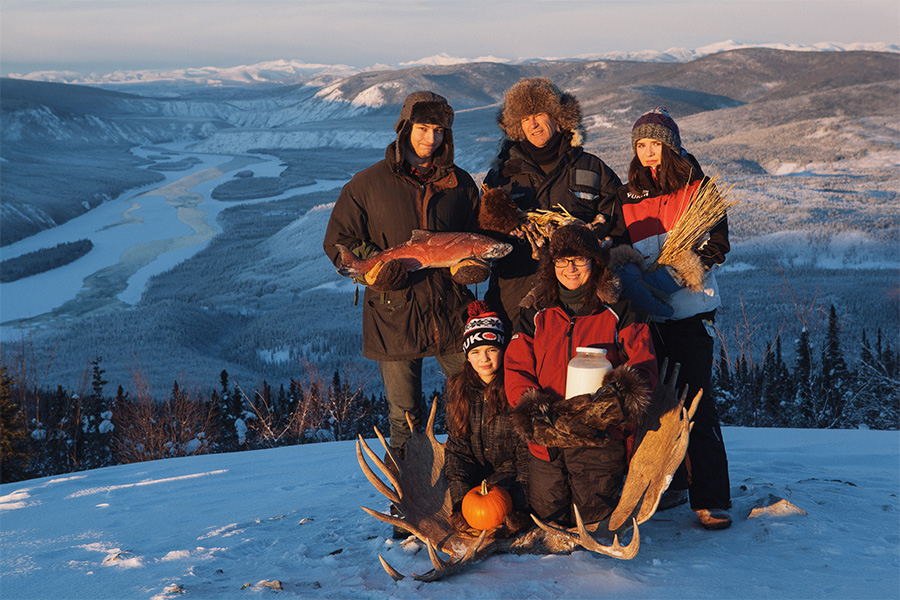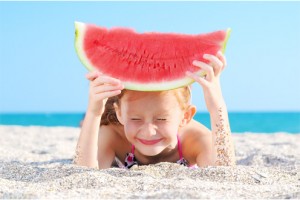I Spent a Year in the Yukon Feeding My Family on Food That Could be Gathered or Grown. Here’s What We Learned.

I have a friend who affectionately refers to me as the Mom who makes films about torturing her children. I guess it’s all about perspective. In 2010 my husband and I took our three kids, aged 10, 8 and 4, to live in the Yukon wilderness for 9 months – no friends, no toys, no running water, no phone, no internet, no electricity – over the winter.
It turned out to be the best year of our life as a family. And into a film that has travelled the world.
Fast forward 7 years and I had another great idea. This time, I decided to put food security to the test in the North and suggested we spend one year with absolutely no grocery store food in our house. And now that my kids are all teenagers, my family thought I had lost it.
A few things that are important to understand about me: I live 300 km south of the Arctic Circle. In Dawson City, Yukon. The closest Starbucks is 550 km away. I can’t keep a houseplant alive for the life of me. I’ve never enjoyed cooking. And, before I married a moose hunter, I was a vegetarian.
But I was convinced I could win my kids over through their stomachs. Did I mention that they eat a lot? I would become a cook. I would learn to make everything from scratch – butter, cheese, ice cream, crackers, sourdough bread. I would become one with meat. After all, there is no protein source in the North that does not come from an animal. I would forage food from the land. I would learn how to preserve foods, despite having no access to salt or vinegar. We would hunt, we would fish. I would garden.
I had heard many complaints from my kids over the years about not being able to live on bagels and cream cheese alone, and wasn’t it part of my responsibility as a parent to cook proper meals? Not to mention, a husband who felt like I was never home enough to fulfill my share of the domestic duties. (Did I mention that it’s all about perspective?)
So, I thought, what better project for my family than a film that would have me housebound, almost chained to the kitchen, and responsible for providing them three full meals a day and all their snack food. Surely they would come around. And, in the process, despite themselves, they would come to understand the benefits of eating local. Did you know that 50% of the nutrients in fresh greens are lost within 5 days of picking? Imagine what nutrition is left by the time fresh greens reach my plate in January in Dawson City!
Indigenous people of the north ate entirely local for thousands of years prior to colonization. Now, 97% of Yukon’s food is trucked in from thousands and thousands of kilometres away. A few years ago, the only road into the Yukon was closed by a landslide. The big supermarket shelves, in Yukon’s capital city of Whitehorse, began to go bare within 48 hours. That was when I realized that grocery stores across North America only stock 3-5 days worth of food. The current COVID-19 pandemic has certainly highlighted our vulnerability when we rely on a centralized food distribution system that comes from afar.
Back to my family. Gradually, I convinced my husband to come on board. I think the concept of me doing more of the cooking helped. When he agreed not to bring any grocery store food into the house, I knew that the challenge was on. After all, my teenagers were not prone to doing the grocery shopping.
I took every bit of grocery store food out of our house. No salt, no sugar, no flour, no caffeine, no alcohol. All the spices gone. The baking cupboard empty. No avocados. No bananas. No chocolate. Quickly I realized how much I rely on a few kitchen staples. What does one substitute for baking powder? How does one make a salad dressing without oil and vinegar? What about salt?
I decided to start the year during the time of plenty – the summer. Summers this far north are short, but intense. Only 66 consecutive frost-free growing days, but 24 hours of sunlight – you can almost watch things grow! But I underestimated the time it would take to forage and harvest and preserve. I needed to appeal to my family to help. I didn’t have much leverage, since this was my idea. As I asked for more and more help, I could feel the rising tide of resentment. I wasn’t off to a particularly good start.
I had no idea how much food a family of five would consume in a year. This caused some anxiety as I knew that I couldn’t go to the store if we ran out of anything. And the goal was not to starve my family. I already had doubts about how we would keep our Vitamin D levels up during the winter. (Commercial milk has added Vitamin D.) Would we all end up with scurvy without oranges?
I turned to my community. A community full of knowledge holders – Tr’ondëk Hwëch’in elders, foragers, intrepid northern family farmers, home gardeners, cooks. People shared garden space, gave me tips from bygone days, shared recipes, taught me how to forage, grew us food.
The learning curve was steep, but I transformed. Now I cook. I’m expanding the garden. I still forage. I continue to stock our house with a year’s worth of local food every fall. It is true that my secret drawer of chocolate has returned. And my kids once again eat bagels and cream cheese. But I would say I continue to eat 95% local and my family 75%.
And although the year is still too fresh for my teenagers to have forgotten the struggles, this summer they are helping out on local farms. My son just announced he is about to go into the bush for a month to pick morel mushrooms. Somewhere deep inside, an appreciation for where our food comes from definitely sunk in.
~By Suzanne Crocker
Suzanne Crocker received national and international acclaim for her first feature POV documentary “All The Time in The World” (2014) for which she was also director, producer, cinematographer and had turned her camera on herself and her family. Winner of 22 Festival Awards from around the world including 9 Audience Choice Awards, 4 Best Picture Awards, 7 Environmental Awards, 6 Youth Awards, including Top 20 Audience Picks at Hot Docs, and Most Popular Canadian Documentary at the Vancouver International Film Festival. All The Time in The World has screened in over 25 countries, on all continents, and been translated into 12 languages.
You can find out more at FirstWeEat.ca and facebook.com/FirstWeEatProject













